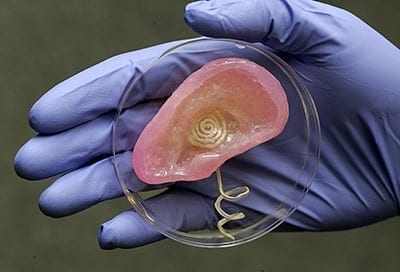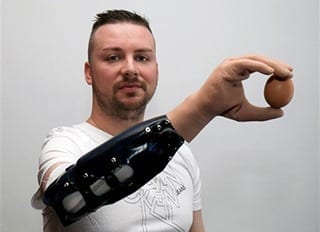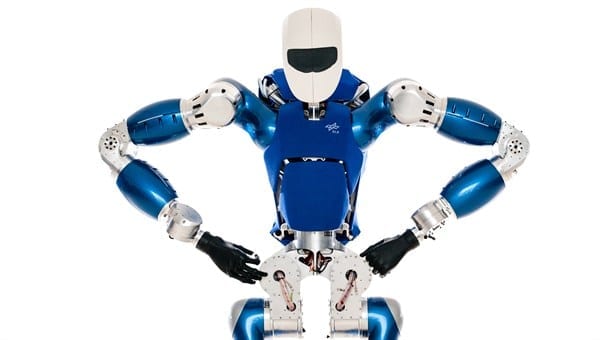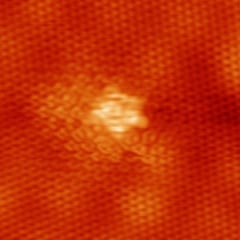
Using 3-D printing tools, scientists at Princeton University have created a functional ear that can “hear” radio frequencies far beyond the range of normal human capability.
The researchers’ primary purpose was to explore an efficient and versatile method of merging electronics with tissue. The scientists used 3-D printing of cells and nanoparticles — with an off-the-shelf printer purchased off the Internet — followed by cell culture to combine a small coil antenna with cartilage, creating what they term a bionic ear.
“In general, there are mechanical and thermal challenges with interfacing electronic materials with biological materials,” said Michael McAlpine, an assistant professor of mechanical and aerospace engineering at Princeton and the project’s lead researcher. “Previously, researchers have suggested some strategies to tailor the electronics so that this merger is less awkward. That typically happens between a 2-D sheet of electronics and a surface of the tissue. However, our work suggests a new approach — to build and grow the biology up with the electronics synergistically and in a 3-D interwoven format.”
McAlpine’s team has made several advances in recent years involving the use of small-scale medical sensors and antennas. Last year, a research effort led by McAlpine, Naveen Verma, an assistant professor of electrical engineering, and Fiorenza Omenetto of Tufts University resulted in the development of a “tattoo” made up of a biological sensor and antenna that can be affixed to the surface of a tooth.
This project, however, is the team’s first effort to create a fully functional organ: one that not only replicates a human ability, but extends it using embedded electronics.
“The design and implementation of bionic organs and devices that enhance human capabilities, known as cybernetics, has been an area of increasing scientific interest,” the researchers wrote in an article published online May 1 in the scholarly journal Nano Letters. “This field has the potential to generate customized replacement parts for the human body, or even create organs containing capabilities beyond what human biology ordinarily provides.”
Standard tissue engineering involves seeding types of cells, such as those that form ear cartilage, onto a scaffold of a polymer material called a hydrogel. However, the researchers said that this technique has problems replicating complicated three-dimensional biological structures. Ear reconstruction “remains one of the most difficult problems in the field of plastic and reconstructive surgery,” they wrote.
To solve the problem, the team turned to a manufacturing approach called 3-D printing. These printers use computer-assisted design (CAD) to conceive of objects as arrays of thin slices. The printer then deposits layers of a variety of materials — ranging from plastic to cells — to build up a finished product. Proponents say the process, also called additive manufacturing, promises to revolutionize home industries by allowing small teams or individuals to create work that could previously only be done by factories.
Creating organs using 3-D printers is a recent advance; several groups have reported using the technology for this purpose in the past few months. But this is the first time that researchers have demonstrated that 3-D printing is an effective strategy for interweaving tissue with electronics.
The technique allowed the researchers to combine the antenna electronics with tissue within the highly complex topology of a human ear. The researchers used an ordinary 3-D printer to combine a matrix of hydrogel and calf cells with silver nanoparticles that form an antenna. The calf cells later developed into cartilage.
Manu Mannoor, a graduate student in McAlpine’s lab and the paper’s lead author, said that additive manufacturing opens new ways to think about the integration of electronics with biological tissue and makes possible the creation of true bionic organs in form and function. He said that it may be possible to integrate sensors into a variety of biological tissues; for example, a doctor could replace a patient’s torn knee meniscus with a bionic one to monitor strain on the new cartilage during physical activities to prevent another tear.
David Gracias, an associate professor of chemical and biomolecular engineering at Johns Hopkins University and co-author on the publication, said that bridging the divide between biology and electronics represents a formidable challenge that needs to be overcome to enable the creation of smart prostheses and implants.
“Biological structures are soft and squishy, composed mostly of water and organic molecules, while conventional electronic devices are hard and dry, composed mainly of metals, semiconductors and inorganic dielectrics,” he said. “The differences in physical and chemical properties between these two material classes could not be any more pronounced.”
The finished ear consists of a coiled antenna inside a cartilage structure. Two wires lead from the base of the ear and wind around a helical “cochlea” — the part of the ear that senses sound — which can connect to electrodes. Although McAlpine cautions that further work and extensive testing would need to be done before the technology could be used on a patient, he said the ear in principle could be used to restore or enhance human hearing. He said electrical signals produced by the ear could be connected to a patient’s nerve endings, similar to a hearing aid. The current system receives radio waves, but he said the research team plans to incorporate other materials, such as pressure-sensitive electronic sensors, to enable the ear to register acoustic sounds.
The Latest Bing News on:
Bionic ear
- The Advent Of Tech In Science: How Optogenetics Seeks To Further The Development Of ‘Bionic Eye’on May 7, 2024 at 3:07 am
Once a topic of science fiction and lore, the idea of restoring eyesight is finally becoming an approachable reality. Today, the idea of building visual prosthesis has become less the subject of ...
- Cochlear Implanton May 6, 2024 at 4:59 pm
The Visual Ear project aims to illustrate the cochlear mechanism as an educational tool. The cochlea itself is the part of the ear that converts the pressure waves of sound into electrical ...
- Bionic Eye Market CAGR of 12.7%, Future Looks Bright for Market Size with Soaring Projectionson May 5, 2024 at 2:45 pm
Bionic Eye Market is valued at approximately USD 183.5 million in 2019 and is anticipated to grow with a healthy growth rate of more than 12.7% over the forecast period 2020-2027. Bionic eye, also ...
- The Nothing Ear and Ear A are the wireless buds I'm recommending to everyoneon May 3, 2024 at 5:01 pm
The Nothing Ear are the best-sounding and most comfortable mid-range earbuds you can buy, while the more affordable Ear A bring Nothing's excellent comfort and features to a lower price range ...
- Miracle-Ear Hearing Aidson April 30, 2024 at 5:00 pm
A trusted resource for hearing solutions for over 70 years, Miracle-Ear uses state-of-the-art technology to remove the barriers of hearing loss. Miracle-Ear specializes in customizable hearing ...
- This bionic eye could restore vision and possibly manipulate our realityon April 30, 2024 at 5:00 pm
The Science Eye is an intriguing piece of technology. Developed by Science Corp., the bionic eye seeks to restore vision in patients suffering from a variety of vision-based diseases. But ...
- Top 8 Best Ear Plugs in 2024on April 26, 2024 at 5:00 pm
The ear plugs are designed with a bionic jellyfish and fit the ear canal 360 degrees, making them breathable, comfortable, and no pain to wear for a long time. The ear plugs can block some noise ...
- The Best Earbuds (In-Ear Headphones) for 2024on April 23, 2024 at 5:00 pm
I've been a contributing editor for PCMag since 2011. Before that, I was PCMag's lead audio analyst from 2006 to 2011. Even though I'm a freelancer now, PCMag has been my home for well over a ...
- How To Get Water Out of Your Earon April 20, 2024 at 5:00 pm
You do not have to be a swimmer to get water trapped in your ear canal. It can happen after any type of exposure to water, and it may cause a tickling sensation in your ear and affect your hearing.
- Nothing Ear (a) review: Proof you don't need expensive earbudson April 18, 2024 at 3:46 am
That continues with a new addition to their Ear lineup, the Nothing Ear (a). Launched alongside the Ear (Nothing dropped numeric designations this year), Nothing Ear (a) is the successor to the ...
The Latest Google Headlines on:
Bionic ear
[google_news title=”” keyword=”bionic ear” num_posts=”10″ blurb_length=”0″ show_thumb=”left”]
The Latest Bing News on:
3D printed bionic ear
- Tethon 3D Launches Bison Bio, a New Bioprinteron May 7, 2024 at 8:19 am
Tethon 3D has released a bioprinter. The Omaha-based company primarily makes ceramic and polymer materials for resin 3D printing equipment, but has also branched into making machines themselves. Their ...
- The Best 3D Printers for 2024on May 1, 2024 at 5:00 pm
More affordable than ever, 3D printers are booming for personal, professional, and educational use. Here's everything to know before you buy one, along with the top models from our hands-on testing.
- Man whose hand was crushed in a meat grinder gets bionic 3D-printed fingerson April 2, 2024 at 1:13 am
A keen cyclist who lost part of his hand in a meat grinder is enjoying life back in the saddle after becoming the first person to get 3D-printed bionic fingers. Mo Ali, 40, had four fingers ...
- 3D-printed organs may soon be a reality. 'Looking ahead, we’ll not need donor hearts'on May 10, 2023 at 8:25 pm
The ear on the woman’s right side ... abstract and Dr. Michal Wszola, creator of Bionic Pancreas. United Therapeutics Corporation has 3D printed a human lung scaffold with 4,000 kilometers ...
- 3D-Printed, Factory-Built Homes Coming To A Community Near Youon March 28, 2023 at 6:15 am
Opinions expressed by Forbes Contributors are their own. I'm a journalist covering professional and industrial 3D printing. California-based 3D-printing construction tech company Mighty Buildings ...
- Build Your Own 3D Printed Bluetooth Headphoneson August 5, 2022 at 1:15 am
The Homebrew Headphones website is devoted to just one thing: explaining how you can use common components and some 3D printed parts to ... and replacement ear covers designed for the Bose ...
- 3D-Printed Rockets Set To Blast Offon June 30, 2022 at 9:31 am
Opinions expressed by Forbes Contributors are their own. I'm a journalist covering professional and industrial 3D printing. Relativity Space stage 1 3D-printed rocket being installed at Cape ...
- 3D Printed Cartilage Ushers In Ear-a Of Custom Body Partson June 29, 2022 at 12:40 am
If we could 3D print new custom body par/ts to suit the individual, it would solve a lot of problems. A new ear implant pioneered by 3DBio Therapeutics has achieved just that. Microtia is a ...
- Just Press Printon March 1, 2020 at 6:46 pm
a prototype bionic ear, pizzas—hardly a week goes by without a startling tour de force in the rapidly evolving technology of three-dimensional printing. What sounds like something out of Star ...
- Bionic 3D-printed arm 'gives confidence' to young amputeeson December 9, 2018 at 4:45 pm
A Bristol-based robotics company, Open Bionics, has developed the world's first medically-certified 3D-printed artificial ... Open Bionics hope the £5,000 bionic arm could be made available ...
The Latest Google Headlines on:
3D printed bionic ear
[google_news title=”” keyword=”3D printed bionic ear” num_posts=”10″ blurb_length=”0″ show_thumb=”left”]











